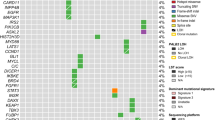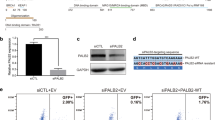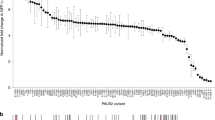Abstract
The major breast cancer suppressor proteins BRCA1 and BRCA2 play essential roles in homologous recombination (HR)-mediated DNA repair, which is thought to be critical for tumor suppression. The two BRCA proteins are linked by a third tumor suppressor, PALB2, in the HR pathway. While truncating mutations in these genes are generally pathogenic, interpretation of missense variants remains a challenge. To date, patient-derived missense variants that disrupt PALB2 binding have been identified in BRCA1 and BRCA2; however, there has not been sufficient evidence to prove their pathogenicity in humans, and no variants in PALB2 that disrupt either its BRCA1 or BRCA2 binding have been reported. Here we report on the identification of a novel PALB2 variant, c.104T>C (p.L35P), that segregates in a family with a strong history of breast cancer. Functional analyses showed that L35P abrogates the PALB2–BRCA1 interaction and completely disables its abilities to promote HR and confer resistance to platinum salts and PARP inhibitors. Whole-exome sequencing of a breast cancer from a c.104T>C carrier revealed a second, somatic, truncating mutation affecting PALB2, and the tumor displays hallmark genomic features of tumors with BRCA mutations and HR defects, cementing the pathogenicity of L35P. Parallel analyses of other germline variants in the PALB2 N-terminal BRCA1-binding domain identified multiple variants that affect HR function to varying degrees, suggesting their possible contribution to cancer development. Our findings establish L35P as the first pathogenic missense mutation in PALB2 and directly demonstrate the requirement of the PALB2-BRCA1 interaction for breast cancer suppression.
This is a preview of subscription content, access via your institution
Access options
Subscribe to this journal
Receive 50 print issues and online access
$259.00 per year
only $5.18 per issue
Buy this article
- Purchase on Springer Link
- Instant access to full article PDF
Prices may be subject to local taxes which are calculated during checkout



Similar content being viewed by others
References
Zhang F, Ma J, Wu J, Ye L, Cai H, Xia B et al. PALB2 links BRCA1 and BRCA2 in the DNA-damage response. Curr Biol 2009; 19: 524–529.
Sy SM, Huen MS, Chen J . PALB2 is an integral component of the BRCA complex required for homologous recombination repair. Proc Natl Acad Sci USA 2009; 106: 7155–7160.
Zhang F, Fan Q, Ren K, Andreassen PR . PALB2 functionally connects the breast cancer susceptibility proteins BRCA1 and BRCA2. Mol Cancer Res 2009; 7: 1110–1118.
Xia B, Sheng Q, Nakanishi K, Ohashi A, Wu J, Christ N et al. Control of BRCA2 cellular and clinical functions by a nuclear partner, PALB2. Mol Cell 2006; 22: 719–729.
Tischkowitz M, Xia B . PALB2/FANCN: recombining cancer and Fanconi anemia. Cancer Res 2010; 70: 7353–7359.
Walsh T, Casadei S, Lee MK, Pennil CC, Nord AS, Thornton AM et al. Mutations in 12 genes for inherited ovarian, fallopian tube, and peritoneal carcinoma identified by massively parallel sequencing. Proc Natl Acad Sci USA 2011; 108: 18032–18037.
Antoniou AC, Casadei S, Heikkinen T, Barrowdale D, Pylkas K, Roberts J et al. Breast-cancer risk in families with mutations in PALB2. N Engl J Med 2014; 371: 497–506.
Oliver AW, Swift S, Lord CJ, Ashworth A, Pearl LH . Structural basis for recruitment of BRCA2 by PALB2. EMBO Rep 2009; 10: 990–996.
Buisson R, Masson JY . PALB2 self-interaction controls homologous recombination. Nucleic Acids Res 2012; 40: 10312–10323.
Sy SM, Huen MS, Zhu Y, Chen J . PALB2 regulates recombinational repair through chromatin association and oligomerization. J Biol Chem 2009; 284: 18302–18310.
Casadei S, Norquist BM, Walsh T, Stray S, Mandell JB, Lee MK et al. Contribution of inherited mutations in the BRCA2-interacting protein PALB2 to familial breast cancer. Cancer Res 2011; 71: 2222–2229.
Reid S, Schindler D, Hanenberg H, Barker K, Hanks S, Kalb R et al. Biallelic mutations in PALB2 cause Fanconi anemia subtype FA-N and predispose to childhood cancer. Nat Genet 2007; 39: 162–164.
Popova T, Manie E, Rieunier G, Caux-Moncoutier V, Tirapo C, Dubois T et al. Ploidy and large-scale genomic instability consistently identify basal-like breast carcinomas with BRCA1/2 inactivation. Cancer Res 2012; 72: 5454–5462.
Nik-Zainal S, Davies H, Staaf J, Ramakrishna M, Glodzik D, Zou X et al. Landscape of somatic mutations in 560 breast cancer whole-genome sequences. Nature 2016; 534: 47–54.
Ding YC, Steele L, Kuan CJ, Greilac S, Neuhausen SL . Mutations in BRCA2 and PALB2 in male breast cancer cases from the United States. Breast Cancer Res Treat 2011; 126: 771–778.
Xia B, Dorsman JC, Ameziane N, de Vries Y, Rooimans MA, Sheng Q et al. Fanconi anemia is associated with a defect in the BRCA2 partner PALB2. Nat Genet 2007; 39: 159–161.
Telli ML, Timms KM, Reid JE, Hennessy B, Mills GB, Jensen KC et al. Homologous recombination deficiency (HRD) score predicts response to platinum-containing neoadjuvant chemotherapy in patients with triple negative breast cancer. Clin Cancer Res 2016; 22: 3764–3773.
Pennington KP, Walsh T, Harrell MI, Lee MK, Pennil CC, Rendi MH et al. Germline and somatic mutations in homologous recombination genes predict platinum response and survival in ovarian, fallopian tube, and peritoneal carcinomas. Clin Cancer Res 2014; 20: 764–775.
Huo Y, Cai H, Teplova I, Bowman-Colin C, Chen G, Price S et al. Autophagy opposes p53-mediated tumor barrier to facilitate tumorigenesis in a model of PALB2-associated hereditary breast cancer. Cancer Discov 2013; 3: 894–907.
Livraghi L, Garber JE . PARP inhibitors in the management of breast cancer: current data and future prospects. BMC Med 2015; 13: 188.
Lord CJ, Ashworth A . BRCAness revisited. Nat Rev Cancer 2016; 16: 110–120.
Hartford SA, Chittela R, Ding X, Vyas A, Martin B, Burkett S et al. Interaction with PALB2 is essential for maintenance of genomic integrity by BRCA2. PLoS Genet 2016; 12: e1006236.
Simhadri S, Peterson S, Patel DS, Huo Y, Cai H, Bowman-Colin C et al. Male fertility defect associated with disrupted BRCA1-PALB2 interaction in mice. The J Biol Chem 2014; 289: 24617–24629.
Wang L, Di LJ . BRCA1 and estrogen/estrogen receptor in breast cancer: where they interact? Int J Biol Sci 2014; 10: 566–575.
Tischkowitz M, Xia B, Sabbaghian N, Reis-Filho JS, Hamel N, Li G et al. Analysis of PALB2/FANCN-associated breast cancer families. Proc Natl Acad Sci USA 2007; 104: 6788–6793.
Kohsaka S, Shukla N, Ameur N, Ito T, Ng CK, Wang L et al. A recurrent neomorphic mutation in MYOD1 defines a clinically aggressive subset of embryonal rhabdomyosarcoma associated with PI3K-AKT pathway mutations. Nat Genet 2014; 46: 595–600.
Ho AS, Kannan K, Roy DM, Morris LG, Ganly I, Katabi N et al. The mutational landscape of adenoid cystic carcinoma. Nat Genet 2013; 45: 791–798.
Piscuoglio S, Burke KA, Ng CK, Papanastasiou AD, Geyer FC, Macedo GS et al. Uterine adenosarcomas are mesenchymal neoplasms. J Pathol 2016; 238: 381–388.
Li H, Durbin R . Fast and accurate short read alignment with Burrows-Wheeler transform. Bioinformatics 2009; 25: 1754–1760.
McKenna A, Hanna M, Banks E, Sivachenko A, Cibulskis K, Kernytsky A et al. The Genome analysis toolkit: a mapreduce framework for analyzing next-generation DNA sequencing data. Genome Res 2010; 20: 1297–1303.
Cibulskis K, Lawrence MS, Carter SL, Sivachenko A, Jaffe D, Sougnez C et al. Sensitive detection of somatic point mutations in impure and heterogeneous cancer samples. Nat Biotechnol 2013; 31: 213–219.
Saunders CT, Wong WS, Swamy S, Becq J, Murray LJ, Cheetham RK . Strelka: accurate somatic small-variant calling from sequenced tumor-normal sample pairs. Bioinformatics 2012; 28: 1811–1817.
Koboldt DC, Zhang Q, Larson DE, Shen D, McLellan MD, Lin L et al. VarScan 2: somatic mutation and copy number alteration discovery in cancer by exome sequencing. Genome Res 2012; 22: 568–576.
Shen R, Seshan VE . FACETS: allele-specific copy number and clonal heterogeneity analysis tool for high-throughput DNA sequencing. Nucleic Acids Res 2016; 44: e131.
Piscuoglio S, Ng CK, Murray MP, Guerini-Rocco E, Martelotto LG, Geyer FC et al. The genomic landscape of male breast cancers. Clin Cancer Res 2016; 22: 4045–4056.
Carter SL, Cibulskis K, Helman E, McKenna A, Shen H, Zack T et al. Absolute quantification of somatic DNA alterations in human cancer. Nat Biotechnol 2012; 30: 413–421.
Lawrence MS, Stojanov P, Polak P, Kryukov GV, Cibulskis K, Sivachenko A et al. Mutational heterogeneity in cancer and the search for new cancer-associated genes. Nature 2013; 499: 214–218.
Schwarz JM, Rodelsperger C, Schuelke M, Seelow D . MutationTaster evaluates disease-causing potential of sequence alterations. Nat Methods 2010; 7: 575–576.
Carter H, Chen S, Isik L, Tyekucheva S, Velculescu VE, Kinzler KW et al. Cancer-specific high-throughput annotation of somatic mutations: computational prediction of driver missense mutations. Cancer Res 2009; 69: 6660–6667.
Shihab HA, Gough J, Cooper DN, Stenson PD, Barker GL, Edwards KJ et al. Predicting the functional, molecular, and phenotypic consequences of amino acid substitutions using hidden Markov models. Hum Mutat 2013; 34: 57–65.
Kandoth C, McLellan MD, Vandin F, Ye K, Niu B, Lu C et al. Mutational landscape and significance across 12 major cancer types. Nature 2013; 502: 333–339.
Lawrence MS, Stojanov P, Mermel CH, Robinson JT, Garraway LA, Golub TR et al. Discovery and saturation analysis of cancer genes across 21 tumour types. Nature 2014; 505: 495–501.
Futreal PA, Coin L, Marshall M, Down T, Hubbard T, Wooster R et al. A census of human cancer genes. Nat Rev Cancer 2004; 4: 177–183.
Hu Y, Yan C, Hsu CH, Chen QR, Niu K, Komatsoulis GA et al. OmicCircos: a simple-to-use r package for the circular visualization of multidimensional omics data. Cancer Inform 2014; 13: 13–20.
Alexandrov LB, Nik-Zainal S, Wedge DC, Aparicio SA, Behjati S, Biankin AV et al. Signatures of mutational processes in human cancer. Nature 2013; 500: 415–421.
Alexandrov LB, Nik-Zainal S, Wedge DC, Campbell PJ, Stratton MR . Deciphering signatures of mutational processes operative in human cancer. Cell Rep 2013; 3: 246–259.
Cancer Genome Atlas Network. Comprehensive molecular portraits of human breast tumours. Nature 2012; 490: 61–70.
Tischkowitz M, Sabbaghian N, Ray AM, Lange EM, Foulkes WD, Cooney KA . Analysis of the gene coding for the BRCA2-interacting protein PALB2 in hereditary prostate cancer. Prostate 2008; 68: 675–678.
Bogdanova N, Sokolenko AP, Iyevleva AG, Abysheva SN, Blaut M, Bremer M et al. PALB2 mutations in German and Russian patients with bilateral breast cancer. Breast Cancer Res Treat 2011; 126: 545–550.
Nguyen-Dumont T, Hammet F, Mahmoodi M, Tsimiklis H, Teo ZL, Li R et al. Mutation screening of PALB2 in clinically ascertained families from the Breast Cancer Family Registry. Breast Cancer Res Treat 2015; 149: 547–554.
Zheng Y, Zhang J, Niu Q, Huo D, Olopade OI . Novel germline PALB2 truncating mutations in African American breast cancer patients. Cancer 2012; 118: 1362–1370.
Ding YC, Steele L, Chu LH, Kelley K, Davis H, John EM et al. Germline mutations in PALB2 in African-American breast cancer cases. Breast Cancer Res Treat 2011; 126: 227–230.
Teo Z, Park DJ, Provenzano E, Chatfield CA, Odefrey FA, Nguyen-Dumont T et al. Prevalence of PALB2 mutations in Australasian multiple-case breast cancer families. Breast Cancer Res 2013; 15: R17.
Blanco A, de la Hoya M, Osorio A, Diez O, Miramar MD, Infante M et al. Analysis of PALB2 gene in BRCA1/BRCA2 negative Spanish hereditary breast/ovarian cancer families with pancreatic cancer cases. PLoS One 2013; 8: e67538.
Tischkowitz M, Capanu M, Sabbaghian N, Li L, Liang X, Vallée MP et al. Rare germline mutations in PALB2 and breast cancer risk: a population-based study. Hum Mutat 2012; 33: 674–680.
Acknowledgements
We thank Olga Aleynikova MD, Andrew Shuen MD, Nelly Sabbaghian MSc, Sonya Zaor MSc and Nancy Hamel MSc for their assistance. BX is supported by the National Cancer Institute (R0A138804 and R01CA188096). WDF is funded by Susan G Komen and the Quebec Breast Cancer Foundation. KAB, SHB, BW and JRF are supported in part by a Cancer Center Support Grant of the National Cancer Institute (grant No P30CA008748). MT is funded by the European Union Seventh Framework Program (2007Y2013)/European Research Council (Grant No. 310018). SLN is supported by Morris and Horowitz Endowed Professorship and the National Cancer Institute (R01CA184585). NZ is a Mitch Garber Postdoctoral Fellow. This research was supported by the Flow Cytometry Core Facility of Rutgers Robert Wood Johnson Medical School, a Shared Resource of The Rutgers Cancer Institute of New Jersey (P30CA072720), and a NIH Shared Instrumentation Grant (1 S10 RR025468).
Author information
Authors and Affiliations
Corresponding author
Ethics declarations
Competing interests
The authors declare no conflict of interest.
Additional information
Supplementary Information accompanies this paper on the Oncogene website
Rights and permissions
About this article
Cite this article
Foo, T., Tischkowitz, M., Simhadri, S. et al. Compromised BRCA1–PALB2 interaction is associated with breast cancer risk. Oncogene 36, 4161–4170 (2017). https://doi.org/10.1038/onc.2017.46
Received:
Revised:
Accepted:
Published:
Issue Date:
DOI: https://doi.org/10.1038/onc.2017.46
This article is cited by
-
PALB2 germline mutations in a large cohort of Middle Eastern breast-ovarian cancer patients
Scientific Reports (2023)
-
Breast cancer in the era of integrating “Omics” approaches
Oncogenesis (2022)
-
A phase II study of talazoparib monotherapy in patients with wild-type BRCA1 and BRCA2 with a mutation in other homologous recombination genes
Nature Cancer (2022)
-
Functional assessment of missense variants of uncertain significance in the cancer susceptibility gene PALB2
npj Breast Cancer (2022)
-
Breast cancer risks associated with missense variants in breast cancer susceptibility genes
Genome Medicine (2022)



